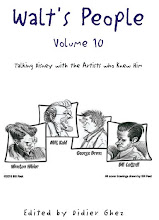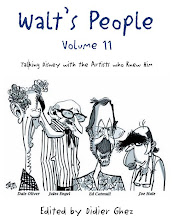
Here is a document I just found online and that I think some of you will enjoy.
Film Music and Its Use in Beaver Valley
As remembered by James Algar in 1950.
This article was first released in Film and TV Music (November-December 1950).
When I went back in retrospect to our discussion of the music before Paul Smith began the Beaver Valley score, and when I began to consider the task of explaining some of our problems to an audience, I remembered an article by Robert U. Nelson published several years ago in The Pacific Spectator. Its title was The Craft of the Film Score. Mr. Nelson
pointed out that music for films and concert music are two different mediums:
“The distinction is important. In writing concert music, the composer is all-powerful; he may write anything he chooses. In the films, all this is changed. The composer is no longer a free agent; he must follow the split-second timings of the cue sheet and he must carefully subordinate his music to the dialogue... Film music cannot possibly follow, excepting in spots where there is no dialogue, an independent, abstract development. Its form is necessarily less tip-lit than that of concert music, its themes and motifs less rigorously worked out. The difference in structure between a film score and a symphony is so apparent as to cause some people to conclude that film music has no form. This is not true, yet the presentation of ideas in a film score is undeniably loose and fragmentary.”
Suppose we see how these observations apply to Beaver Valley.
If the composer must play "second fiddle" to the screen, then his music must follow the tempo, the pantomime and the other accidentals of screen story-telling.
And if he must give way constantly to narration and dialogue, how can he be expected to accomplish anything? Well, the composer can and does make important contributions to a film. Certainly Paul Smith's score was tremendously effective in Beaver Valley.
Film music gives a continuity and a cohesion to screen material; this was particularly true in Beaver Valley. It contributes mood, a feeling of warmth, an emotional tone. It "points up" action, and as you have seen, it definitely adds humor.
The music for Beaver Valley was written after the continuity of scenes had been worked out, after the editing was done and after the narration was written. And so one of the first problems the composer had to cope with was the amount of narration. The audience must hear the narrator, or there is no story, thus the music must be subdued when he is talking. This problem is partially solved by the right kind of orchestration during such passages. But of course the real solution lies in having a plan ahead of time so that the narrator is not talking in those sections where the music is to be most effective. It's a compromise situation of give and take. Indeed, in many spate throughout Beaver Valley the music became the story-telling voice, acting .for the moment, as a second narrator.
In terms of the story he had to help tell, the composer was faced with many other problems when he first sat down to score the picture. These included a hero in the beaver who was so busy and plodding he was unspectacular; a villain in the coyote who threatened but never quite caught up with his intended victims; a miscellaneous cast of characters in terms of the number and variety of animals; a quality in the humor that was sometimes gentle, sometimes playful but rarely ever slapstick. Finally, it had to be remembered that these were real animals, not the usual Disney animals of fantasy. Thus the music couldn't be too weird, or too fantastic or too extreme in direction.
In the beginning, certain musical themes were discussed in terms of the personalities of the animals involved or of the character of the material the music would accompany. It was decided that four main themes would recur throughout the picture.
First the setting of Beaver Valley itself seemed to call for a descriptive theme. We came to refer to this as the "Nature Theme." It was to have simplicity, a certain pastoral quality, dignity, and in general a feeling of the bigness of the outdoors. At the same time it had to be flexible enough that it could stand a bit of musical "embroidery" later when the various animals were introduced. The chipmunk, the moose, the marmot, the raccoon all were brought into the story during this part of the musical development.
Next came the problem of a "Beaver Theme", an important motif that would be heard several times in the picture. It seemed to call for a certain plodding, even tempoed progression to fit the busy animal's personality. And it had to lend itself to development and new coloration as we followed the beaver's fortunes through the seasons.
When the coyote entered the story, we knew we needed a warning note of menace, still the motif had to be short and immediately recognizable in a few notes, for the coyote's entrances and exits were to be sudden and brief.
And lastly the playful otters, whose personality was the exact opposite of that of the busy beaver, demanded a theme of their own. They were everything the beaver wasn't. Where he was serious, they were gay; where he moved cautiously, they went at things with abandon. Otters have as much nervous energy as any animals alive, and apparently never sit still. And so their music was made riotous and lively. The tempo was a lively march tempo, full of spirit and movement; the otter theme was purposely patterned after circus music. In fact, an arrangement was written for the U.C.L.A. band of 110 pieces and the number has become their entrance march at football games. The otter theme also has been adapted in a popular version. Lyrics were written and it now is heard under the title of Jing-a-ling Jing-a-ling. The original theme was such a catchy tune it seemed to lend itself naturally to such exploitation.
There were other somewhat incidental themes in Beaver Valley. They were incidental only in that they solved the problem of a particular episode but were not used again in the score; they proved to be highlights musically. One of these situations was that of the young ducks learning to fly. The music for this bit of action was definitely tongue-in-cheek and written to heighten an already humorous situation. Even the quacking of the baby ducks was made “musical,”… that is, was made to follow the tempo of the theme.
Then there was the Frog Symphony. In this instance humor was derived from the very seriousness of the music. The orchestra played the Sextet from Lucia absolutely straight, and the frogs carried their parts as soberly as opera singers. The effect of course was quite the opposite.
Here then were two instances in Beaver Valley wherein the music definitely heightened the humor. In contrast the episode of the spawning salmon found music called upon for something quite different. Here it had to capture the excitement of the magnificent leaps as the salmon fought their way through the rapids; at the same time it had to suggest some of the menace of the bear; and above all it had to underscore the poignant quality of the salmon's valiant fight.
There is one thing perhaps which sets the Beaver Valley score apart from others of its kind. I believe one of the reasons the music is effective is the fact that we used an animated cartoon technique in a live-action film. Musically speaking, I mean by this that we synchronized our music to our screen pantomime more often and more closely than is generally done in live-action movies. This was attempted not only in the major sequences where the ducks quacked to a tempo and the frogs croaked in unison with the orchestra, but all the way through the picture in little individual situations. The composer once told me he had written his score with a "loving touch". He meant, I'm sure, the musical effects in such scenes as the one where the marmot on the rook yawns and stretches... where the raccoon caught the crayfish, and where the otter poked his head up through the thin ice.
To get this close synchronization requires patience, time and careful planning. It involves a thorough study of the picture by the composer. It means running the picture back and forth on a Moviola while the action is observed scene by scene; it means timing these actions with a stop-watch; it means coping with the mathematics of the problem of so many feet passing through the projector in so many seconds accompanied by so many bars of music to such and such a tempo.
Paul Smith once told me that he definitely tried to write a score that was not pretentious. He said, "I tried to write music that was in keeping at all tines with the picture. I simply tried to do an honest job of scoring." In this, I believe he succeeded.






















1 comment:
Great article. I knew Paul Smith while working at Disney. Paul's brother, Art Smith was my brother's music teacher.
I loved working with these wonderful Disney musical talents, and got to know most of them. Ollie Wallace, Paul Smith and George Bruns. All great guys with loads of talent.
Post a Comment